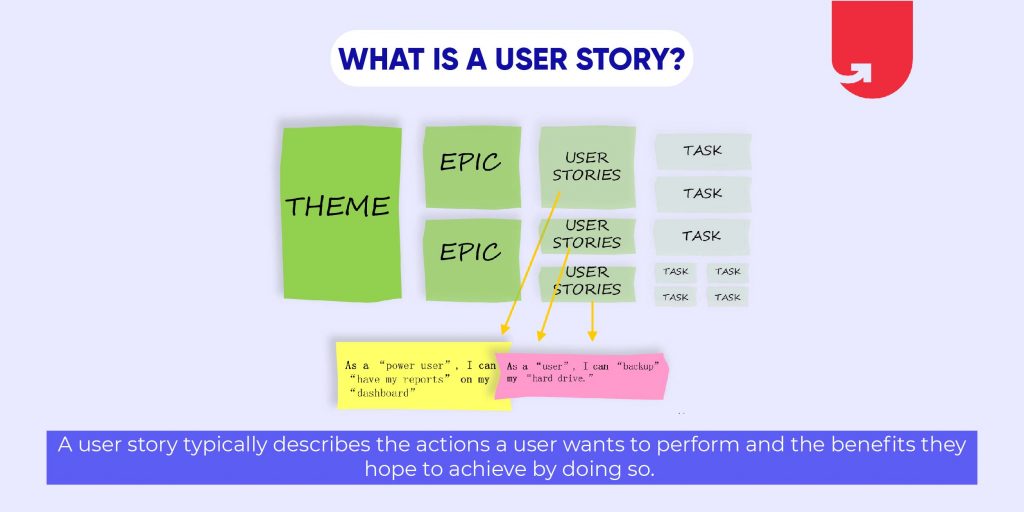In Agile software development, we often encounter two terms– use cases and user stories. These are some of the most common terms used by any developer or a non-developer following their frequent use. Moreover, for those who don’t have any background knowledge of development, using these terms interchangeably is also quite common.
Use cases and user stories are different from one another in many aspects. They have different objectives to be carried out. Although they might have similar functionalities, the concepts are poles apart.
Check out free courses to upskill yourself
In this article, we’ll discuss use cases vs user stories with examples, along with an explanation of how are user stories different from use cases. We’ll also examine the need for the two approaches and why they overlap.
What is Use Case?
Use case reflects a process involved in achieving the goal of the desired product. It is the requirement of the system that helps derive the product. It works as a product description for the actors (or users) who will use it. In technical terms, it is the interaction between the system and the actors via description.
Some of the critical elements of use cases:-
- The actor: A person or group of people who interact with the system
- The goal: The end outcome for which use cases are developed
- The system: All the steps involved to achieve the goal
Use cases carry a cause-and-effect relationship that includes certain events where the functions or the features of a product are described to the end user. It provides a detailed understanding of the user behavior while interacting with the system.
The product team utilizes use cases in designing, testing, and developing products. It helps them outline the requirements of how a user help manual should be designed. Along with that, they’re also able to eliminate errors.
Use cases are detailed descriptions of the product for stakeholders or end users.
Example of Use Case
Let’s take an example of an apparel brand application created to satisfy the customers’ clothes and accessories delivery requirements. Customers browse through the app, select the most suitable item(s), and place an order. While placing an order, they can either pay online or after delivery. After confirmation from the customer’s side, they receive the confirmation mail or notification of “order placed”.
The order is then prepared, packed, and shipped to the address. In this scenario, the application must receive orders and process payment options while communicating with both parties (customers and retailers). Here:
- The system is– an e-commerce application
- The primary actor is– the customer
- The scenario is– browsing through the application
Here you can read how customers and retailers interact with the application and expect the desired outcome. Some of the basic use case descriptions would be:-
- The user selects an item.
- Payment and shipping information
- Confirmation order and checkout
- Order countdown time or tracking
- Billing information
Let us head over to the user story and understand how are user stories different from use cases.
What is User Story?
A user story is a short description of products for the users that guide them throughout the process. Each user story is written from the customer’s perspective with easy-to-understand language. A user story focuses on what a user wants from the platform and what the system should offer them.

The development team then incorporates the users of the statements given into the software with some fixations. User stories consist of the interaction that happens throughout the process via software. Three Cs are involved in user stories, a concept brought up by Ron Jeffries. These are-
- Card: The user stories should be written as cards, which means short and crisp stories with all the necessary information.
- Conversation: A user story should be a conversation between the customers and developers via software.
- Confirmation: This means that the customers confirm certain conditions that should be implemented before the outcome arrives. The system should be able to execute it properly.
Besides these three Cs of a user story, it also focuses on one more important purpose: INVEST. It stands for
- Independent: of other projects
- Negotiable: space for further development
- Valuable: description for the users
- Estimable: user story to execute a proper plan
- Small: work-days to finish the work within 3-5 days
- Testable: Mechanism to check the value or validity of the process
Example of a User story
User stories are expressed as follows:
“As a (persona), I (want to), (so that).”
- As a (persona)– The person for whom the application or software is built. It should emphasize the end-user.
- I (want to)– Here, the intent is being described, not the features. It should describe the user’s goal and not the part of the application or UI.
- (So that)– This describes the overall benefit or the bigger picture of the application. What is the overall benefit that the end user would experience?
Here are a few examples of user stories
- As Elie, I want to link my credit card to my profile so I can pay rent easily without cash.
- As a manager, I want to organize my work so that I can feel more in control.
The structure of the user story could differ, but the intention should be the same.
Why do we need Use Case and User Story?
There are some reasons why we need both use cases and user stories in our system. Let’s delve into the purpose behind a user story and use case:-
We need use cases to–
- Manage the scope of the work
- Facilitate communication between the end users and the developers
- Establish all the requirements
- Visualize system architecture
- Outline the structure through which we can interact with the system
We need user stories to –
- Create a streamlined process
- Create small achievable goals
- Keep both technical and non-technical users on the same page
- Define the whole process
Check our US - Data Science Programs
Difference between Use Case and User Story
Let’s take a look at the difference between use case and user story to understand what makes the two distinct:-
- Use cases are developed for the product team by keeping the intent of stakeholders in mind. It outlines the achievement structure for the team to make the desired software. Use cases tend to be more detailed than user stories.
User stories are simpler and more user-focused. It highlights the routine chores of users, which is why the language used in user stories is comprehensible and entirely from the stakeholder’s viewpoint. - As mentioned, use cases are more straightforward than user stories. However, both approaches are simplified and easy to understand.
- User stories deliberately leave some scope for improvement. Because of this, it needs to include more details.
In contrast, use cases are to the point and highlight all the steps needed to follow by the developers. - User stories are developed before use cases and are mainly formed by interaction.
Read our Popular US - Data Science Articles
When to use a use case and a user story?
User stories are used for product development, and the approach is more inclined toward customers. As mentioned, user stories deliberately leave room for improvement that takes place through conversations between the developers and users. It sets a goal at the beginning of the process, and they are responsible for increasing efficiency. A developer can keep these points in mind while creating user stories.
Use cases, however, are used to document the process. It consists of all the process requirements to reach the end goal. Use cases draw a bigger picture of the existing system. It involves straightforward points for an easy development process.
Boost your Career with upGrad
The right higher education can make a significant difference for all aspiring developers and data scientists. If you are looking for an opportunity to improve your skills and credentials, upGrad’s Executive PG Programme in Data science can be an excellent choice. With this course, learners get outstanding exposure to the technical world. WES and the Institute of Analytics recognize the value of this course which is curated under the expertise of leading industry professionals.
Conclusion
Agile software development revolves around developing iterations, methodologies, and techniques to incorporate user viewpoints. Because of this, the demand is constantly increasing. Every industry focuses on developing use cases and user stories into their system so that each outcome turns out to be customer-centric, thereby increasing customer satisfaction.






























![Top 25 Highest Paying Jobs in the World in 2024 [A Complete Guide]](/__khugblog-next/image/?url=https%3A%2F%2Fd14b9ctw0m6fid.cloudfront.net%2Fugblog%2Fwp-content%2Fuploads%2F2021%2F06%2F04134425%2F2112.png&w=3840&q=75)

![Top 25 Highest Paying Jobs in India [2024] – Latest & Trending](/__khugblog-next/image/?url=https%3A%2F%2Fd14b9ctw0m6fid.cloudfront.net%2Fugblog%2Fwp-content%2Fuploads%2F2020%2F05%2FTop-10-Highest-Paying-Jobs-in-India.png&w=3840&q=75)
![Top 19 Online Certificate Courses With High Salary in India [2024]](/__khugblog-next/image/?url=https%3A%2F%2Fd14b9ctw0m6fid.cloudfront.net%2Fugblog%2Fwp-content%2Fuploads%2F2021%2F01%2F1390.png&w=3840&q=75)